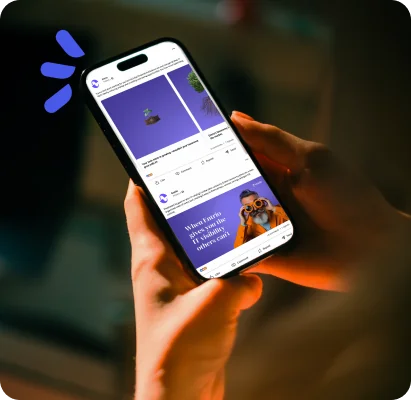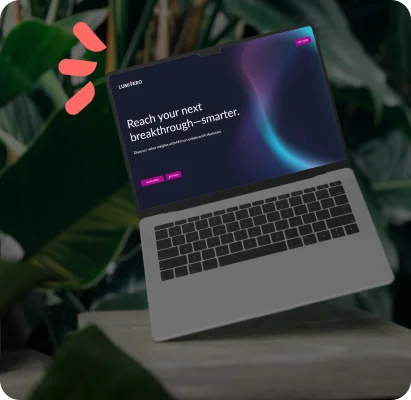Inbound marketing is a powerful way to attract potential customers and nurture leads, but your efforts shouldn’t stop the moment someone fills out a form. To truly capture prospect interest and turn it into revenue, you need a smart, structured way to evaluate leads and act fast when the timing is right.
Strike at the exact right moment, and you could land a new customer. Strike too early or too late, and you lose the chance to even be part of the conversation.
That’s where proper lead scoring and marketing qualified lead (MQL) follow-up come in. (Some say MQLs are dead—we disagree.)
This blog walks through how to set up a lead scoring system, when and how to follow up with MQLs, and best practices to convert more of your inbound leads into customers.
What is lead scoring?
As a marketer, understanding the cues and patterns in your audience helps you identify which contacts are worth passing to sales. Your goal is to hand over quality leads, and lead scoring helps you get there.
In the simplest of terms, lead scoring is the process of assigning values to leads based on:
- Who they are (e.g., job title, industry)
- Where they work (e.g., company name, company size, revenue)
- How they engage with your content (e.g., downloads, website visits, email opens)
This system helps you prioritize leads that align with your Ideal Customer Profile (ICP) and are more likely to convert now. This saves your sales team time in trying to qualify every contact and it also increases your close rates.
Step 1: Setting Your MQL Threshold
Every company defines an MQL differently and your framework should match your unique definition as closely as possible. For example,
- If your target market is mostly C-Suite decision-makers, those titles should garner a higher score than, say, a manager.
- A product page download should carry more weight than a blog view.
The key is to set a scoring threshold that reflects your experience and instinct, one that signals when a lead is truly ready for sales outreach.
Let’s say you’re just starting out and your MQL threshold is 15 points. You might assign:
- 5 points for being a CFO
- 4 points for working at a company with more than 10,000 employees
- 3 points for downloading a whitepaper
- 2 points for visiting your pricing page
- 1 point for reading a blog
Once a lead hits 15 points, they’re flagged as an MQL.
Pro tip: If you’re new to lead scoring, review your model every 1–3 months and loop sales into that conversation. Are the MQLs you’re handing off actually converting? If not, tweak your threshold and scoring model. Your audience behavior and sales goals will evolve, and your scoring model should too.
Want to dig deeper? Check out HubSpot’s guide to lead scoring for more frameworks and examples.
Step 2: MQL Follow Up—Timing Is Everything
Once a lead crosses your MQL threshold, the clock starts ticking, and how fast you respond can make or break the opportunity.
When Should I Follow Up?
- If an MQL requests a demo, fills out a sales contact form or asks for a consultation, aim to follow up within 10 minutes. Your chances of connecting are significantly higher.
- If they haven’t directly requested contact but they’ve met your lead scoring threshold, reach out within 24 hours while you’re still top of mind.
Pro tip: Don’t wait too long! Your chance of converting an MQL into a sales opportunity drops by 15% for every day you delay. 78% of leads purchase from the company that first responds to their inquiry, and conversions are 391% higher when lead response time is in the first minute. (Source: Image Building Media).
Even if the lead isn’t expecting a call, they’re actively researching and evaluating solutions. This means they’re likely on your competitor’s radar too. Be the first to offer value, and you’re much more likely to close.
Step 3: Setting a Follow-Up Cadence
So, how often should you reach out? For inbound MQLs, we recommend at least 6–10 touchpoints across multiple channels (email, phone, social media). This keeps your company top of mind and increases the odds of connecting when the timing is right.
Here’s a proven cadence based on guidance from SalesHacker CEO Max Altschuler:
- Day 1: Email or LinkedIn InMail
- Day 3: Morning email + afternoon call
- Day 5: Morning call + afternoon voicemail
- Day 7: Morning email + afternoon voicemail
- Day 10: Morning email + morning call
Best Days & Times to Reach Out
- Best times to call: 8–9 AM and 4–5 PM (prospect’s time zone)
- Worst time: 1–2 PM (lunch slump)
- Best days: Wednesday and Thursday
According to Robert Clay, the founder of Marketing Wizdom, 80% of MQLs take 4+ touches to close—so persistence matters.
Step 4: Crafting the Right Message
You’ve nailed your timing and set a follow-up cadence—now it’s time to focus on what you’re actually saying.
Spoiler: this is not the moment for a hard sell.
Your goal is to provide value, build trust and spark interest without sounding pushy (or worse, landing in the spam folder).
Your message should add value. Try:
- Sharing a relevant industry article or content offer
- Referencing a mutual connection (can make them 5x more likely to engage)
- Responding to their social post or activity
- Offering a useful suggestion (like a blog or webinar idea)
- Sending a case study that highlights a customer success story
The goal: position yourself as a trusted advisor, not just another salesperson. Make sure every touchpoint answers: “Why is this worth the MQL’s time?”
Step 5: You’ve Made Contact–now what?
Congrats! You’ve started the conversation. Now it’s time to build a real connection and confirm whether this lead is the right fit.
Here’s how to steer that conversation:
- Ask about their organization and uncover pain points.
- Reference content they’ve downloaded, and ask what caught their interest.
- Gauge where they are in the buying process and what kind of solution they’re exploring.
- Don’t jump into a full-blown sales pitch. Nothing kills momentum faster than sounding like a used car salesman.
If the lead is a good fit and timing aligns, try to:
- Book a discovery call
- Schedule a demo
If they’re a good fit but the timing is off, shift them into a nurture stream and continue gathering intel for future outreach.
And if they’re not the right one? Thank them for their time, disqualify the lead and make sure your CRM reflects the update. (Future-you will thank you.)
Don’t Let Good Leads Go Cold
Combining a lead scoring strategy with fast, thoughtful follow-up can make or break your sales results. When done right, you’ll spend less time chasing dead ends and more time closing deals.
If building a lead scoring model or mapping a high-converting outreach plan feels like a stretch, we’ve got you.
Request a consultation with Accelity and we’ll help you convert more leads into customers, faster.
Getting a form fill is exciting—but it’s not the finish line. In fact, it’s just the beginning.
The biggest mistake we see with inbound marketing? Treating a lead like a win instead of a warm-up. Capturing a contact is the easy part. Nurturing that lead into a real opportunity takes strategy, content and a team that knows what to do next.
Generating leads is only the first step to taking new contacts through the sales cycle until they make a purchase decision. Think of this as the “first date.”
This blog breaks down how to keep momentum after conversion—with smart workflows, personalized content and a sales team that’s ready to pounce (nicely).
Set up email workflows
When someone downloads a content offer, that’s a strong buying signal—they’re interested in a specific topic and ready to learn more. Use this moment to trigger an email workflow that delivers related, valuable content. These workflows help “warm up” leads by sharing content that expands on their interests.
The key is to make sure every email has a clear goal and strong purpose. What should the lead do next? Examples of workflow goals include:
- Request a consultation
- Download another offer
- Visit your website
- Subscribe to your blog or newsletter
Once you set your goal, line up content that directly supports it. If your original offer was an ebook on graphic design best practices for startups, follow it up with a blog on website branding tips or a video tutorial on design tools.
Make sure your workflows:
- Include time between emails. Avoid overwhelming your leads with daily emails. Test different sending cadences to see what keeps engagement high without burnout.
- Feature a strong CTA. Don’t dance around your ask—be direct. If your goal is to drive consultation requests, include specific messaging and a clear link to your consultation page.
- Have a logical end point. Don’t let your workflow run indefinitely. Send just enough touchpoints to guide the lead forward—then give them breathing room.
Bonus tip: Use AI to personalize email workflows. Modern marketing platforms can dynamically adjust workflow content and cadence based on lead behavior, helping you tailor each interaction without manual effort. Think Netflix-level personalization for your sales funnel.
Email workflows make sure that the first download isn’t a one-and-done interaction. They provide steady, purposeful engagement that builds trust and ultimately boosts conversions.
Build quality content for the entire inbound process
Once a lead has converted, your job is to keep them moving. That means creating content that not only informs but strategically nudges them toward a buying decision.
Start by mapping content to each stage of the buyer’s journey. Ask yourself:
- What questions does a buyer have at this stage?
- What content will build confidence and address their challenges?
- How can we move them to the next step?
Here’s a breakdown.
| Conversion stage | Goal | Appealing content |
| Strangers to visitors | Grab attention | Use social posts, blogs, and high-volume keywords to appeal to your target audience. |
| Visitors to leads | Encourage action | Offer easily digestible, relevant content specific to certain industries or interests like checklists, guides or short webinars. |
| Leads to customers | Build trust | Share content that connects your solution to their goals—like case studies, demos or landing pages. These can also be used in email workflows. |
| Customers to promoters | Spark loyalty | Provide VIP-level content, sneak peeks and early access. Ask for their input and make them feel seen. |
Pro tip: AI can help identify which stage your leads are in. Tools like predictive analytics and engagement tracking use behavioral data to automatically segment leads and serve the right content at the right time.
Understand lead scoring
Wondering whether your lead nurturing efforts are actually working?
Lead scoring helps you quantify how engaged a contact is, so you can identify which leads are worth a closer look from sales. Once a lead reaches a defined threshold, they’re considered marketing qualified—and ready for direct outreach.
To build a lead scoring system that actually works, you need to define what makes a lead qualified. According to HubSpot, a marketing qualified lead is one who’s more likely to become a customer based on both demographics and engagement behavior.
Here are some scoring criteria to consider:
- Persona
- Industry
- Number of clients
- Company size or number of employees
- Number of downloads
- Website visits
- Email opens or click-throughs
And remember: a score can be less than zero. For example, If your business is a pet store and one of your personas is a non-pet owner, you’d likely apply a negative score.
Of course, the main goal of lead scoring is to move people to become qualified, so you’ll need to consider what each scoring criterion is worth to you and your business.
If someone identifies as a “multiple pet owner,” you’ll need to consider what that information is worth. Do you find that most of your customers are multiple pet owners? If so, you may want to score that persona at a higher level. Go through your list of prospect attributes and make sure the value that you apply to each makes sense.
| Testing Theory You’ve set your lead scoring threshold at 15 points—that’s the magic number that signals when a lead is ready for sales outreach. You’ve created a scoring system that blends both persona and engagement data. Someone who owns multiple pets gets five points right off the bat. A single pet owner scores three. But if the person doesn’t own any pets at all? That’s a red flag for your business, so they get docked 20 points.Beyond personas, you’re also tracking behavior. Every time someone visits your website, they earn a point. If they download a piece of content—say, a guide on choosing the right food for senior dogs—that’s another point. If they open an email and click a link, that’s another one. If they spend time reading your testimonials, they earn two points. And if they start browsing product pages, especially high-intent ones like pet carriers or subscription boxes, that’s worth three points.Over time, a highly engaged lead who fits your target profile racks up points naturally—until they cross that 15-point threshold (at which point sales should be ready to pounce—nicely!). |
Once someone crosses your MQL threshold, sales should reach out with a friendly, helpful message tailored to their behavior. Think of it as the digital equivalent of “May I help you find something?”—but smarter, more strategic, and way more effective.
Pro tip: AI tools like HubSpot’s predictive lead scoring can automatically assign scores based on behavioral patterns and historical customer data—no manual math required.
Finally, don’t “set it and forget it.” Lead scoring works best with:
- Regular updates based on actual conversion data
- Feedback loops with sales (they know what’s working!)
- Score thresholds that reflect real buying behavior, not vanity metrics
Lead scoring is part science, part strategy, and it takes collaboration and iteration to get right.
Give sales the content they need to succeed
Inbound doesn’t stop at marketing. It includes sales, and the two teams need to be synced.
A huge part of inbound marketing is content creation, and if you’ve ever been a marketer or salesperson, you know that sales always needs fresh, relevant and tailored content to keep engagement high and close deals. Think ebooks, blog posts, checklists, videos—anything that helps build credibility and move conversations forward.
To keep engagement high post-conversion, work closely with sales using strategies like:
- Regular meetings. Biweekly or monthly planning sessions help marketing understand sales’ challenges and content needs.
- Sales-written content. Ask your sales reps to contribute to the blog or collaborate on thought leadership pieces. It builds authority and saves you time.
- Content performance analysis. Use analytics to see what content is working. If one lead magnet crushes it, use that format again or, build deeper content around the same topic.
- Message alignment. Sales should understand the story behind every piece of content so they can reference it with confidence. For example:
- Instead of saying, “I saw you downloaded our ebook, so I thought I’d call,” try, “I saw you downloaded our ebook on increasing workplace productivity. I’d love to share a few strategies we’ve seen work for companies like yours.”
Future-forward move: Use AI content assistants like Clay to generate custom follow-up scripts and conversation starters based on each lead’s interaction history.
Sales and marketing should be a well-oiled machine. When both teams align on strategy, messaging and goals, the result is clear: more qualified leads, more closed deals and stronger revenue growth.
The conversion isn’t the end—it’s the starting line
By combining strategic content, smart automation and ongoing collaboration with sales, you’ll move more leads through the funnel—and close more deals, faster.
This blog is part of our inbound marketing series:
- Part 1: Build a lead pipeline that doesn’t waste your time
- Part 3: How to keep growing with retention marketing



